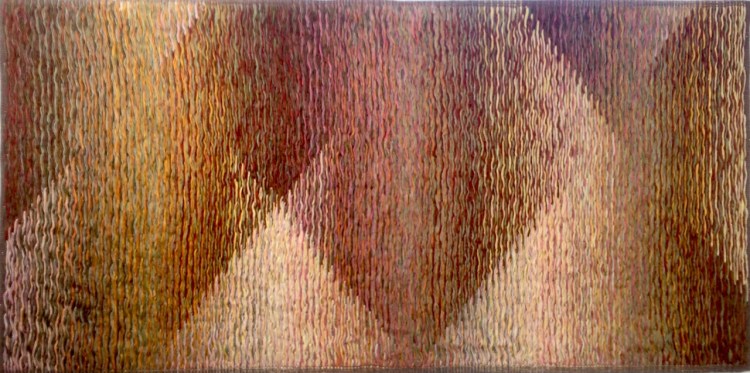

Sondra Bogdanoff, “Wandering,” linen, 22.5 x 46 inches Photo courtesy of the artist
Repetition – of medium, module and method – underlies two exhibitions currently on view in Portland, though to completely divergent effects. What is perhaps most enjoyable (and possibly a bit off-putting in the case of one) is witnessing the tremendous variety possible within that repetition. “Morphatoreum” at Cove Street Arts (through Jan. 13) brings together three artists in conversation through different media. “PerSlovak 2.0” (through Jan. 5) is an interactive photographic display at the Maine Jewish Museum that could not be more timely.
In “Morphatoreum,” Sondra Bogdonoff, Roy Fox and Jamie Johnston all employ repetition but through varied media. Bogdonoff’s work is incredibly subtle, so it may take a moment to realize the enormity of what she is doing. All her compositions use woven linen thread. Many artists have used this material and practice to produce three-dimensional sculpture – most notably, the pioneering Lenore Tawney (1970-2007) – or, like Billie Zangewa, two-dimensional pieces.
What is amazing about my favorite Bogdonoffs, chief among them “Wandering,” “Morning Light” and “Back and Forth,” is how she can create 3D effects in two dimensions by essentially scrambling the picture plane. She does this, in part, by using her medium and her methodology to create a sense of shadow. By alternating the color of the thread and the weave, Bogdonoff leaves us pondering – especially when viewing the works from further away – whether a form is actually floating in front of the plane or receding into it.
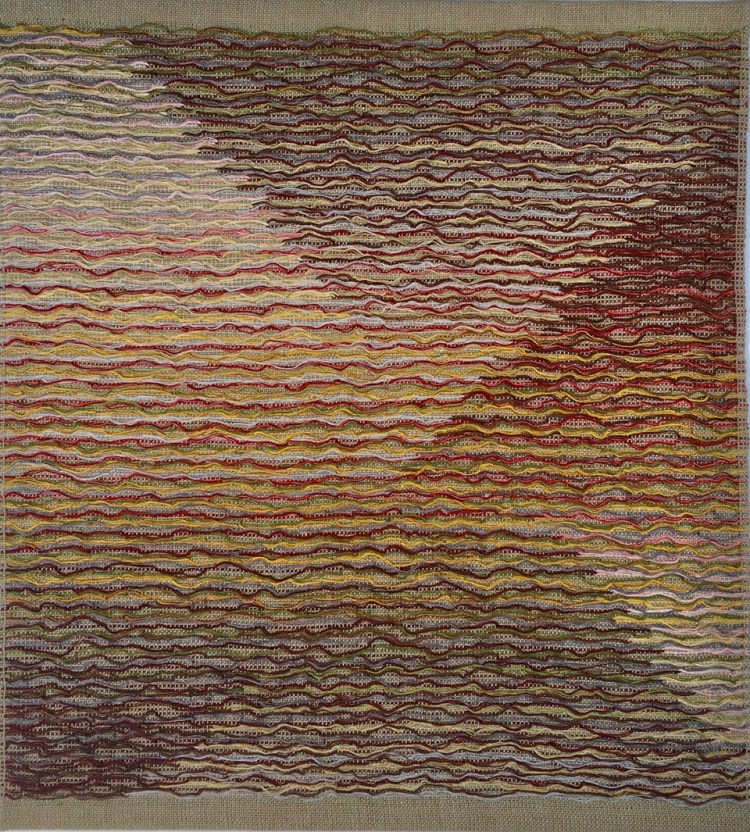

Sondra Bogdonoff, “Morning Light,” linen, 21 x 23.5 inches Photo courtesy of the artist
Compositionally, “Wandering” is a study in diamond shapes, while “Morning Light” investigates triangular forms. Yet her command of color and technique creates a kind of oscillation of form, where the diamonds and triangles are constantly overlapping, fusing together, popping out at the viewer or sinking back into space. The mathematics of this is mind boggling, resembling, in a way, the calculations Sol Lewitt uses to execute compositions of graphite or colored pencil on walls. But whereas LeWitt’s work can seem rigidly formulaic, Bogdonoff’s – perhaps due to the softness of the medium itself and perhaps to the way she alternates tight and loose weaves, sometimes even leaving loose ends – comes off as woozy and dreamy, gently manipulating our perception in ways that draw us into each work.
The effect is, finally, ethereal. In other woven pieces such as “Crossing Lines #2” and “Back and Forth,” Bogdonoff is also able to capture a sense of light emerging from some numinous depth. All this takes incredible mastery.
Fox’s work is the most obviously repetitive in the show. With the exception of three tesserae-like works (“3680.s,” “3670.s” and “3472.s”), all his paintings appear as single vertical strokes of ink, paint and varnish on archival panels. The fascination here is in seeing how this mix of mediums can produce a sense of liquid luminosity that in turn sparks associations with other materials.
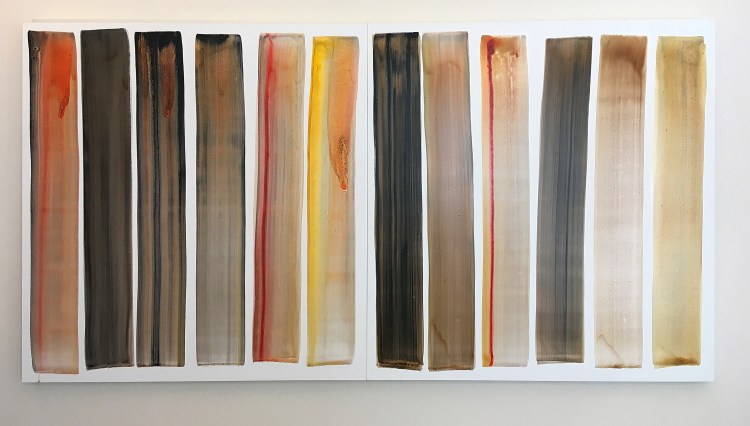

Roy Fox, “3360,” ink, paint and varnish on mounted archival panel, 30 x 60 inches Photo courtesy of the artist
A painting like “3692.s” evokes planks of wood on boardwalks or rickety wooden bridges, while “3357” or “3360” can remind us of the “Stripe” paintings of Color Field artist Morris Lewis from the early 1960s. Like Lewis, in fact, many of Fox’s works revel in the pure materiality of watered-down pigments, the way they still appear wet and also the manner in which they transmit a translucence that serves to filter a simulacrum of background light. The luminosity of Fox’s stripes, in fact, is of a piece with Bogdonoff’s play of light, and we can take enormous pleasure in “listening” to them converse.
Johnston’s work also conveys a sense of materiality and light. His wall sculptures are made of wood that is cut into modules and assembled, then painted in parts. Whereas Fox and Bogdonoff seem to conjure light and/or filter it, the role of light in Johnston’s wood works is more passive. Mainly they catch it, break it up and create shadow. They are interactive in the sense that, to get the morphing effects they create, we must walk along them or otherwise change our position.
I had seen “Parrot’s Talk” in another show and appreciated the way its color and two-dimensionality suggested the animal and the aural activity of its title. It and other wall sculptures play with what we perceive as continuous accordion folds, particularly “Listing 17,” which appears like nothing so much as an accordion bellows stretched open and sagging in the middle.
But Johnston has painted the foreground border of the wooden wedges red and the inside space between wedges a turquoise blue. If we view this from one side or another, we only see the red. But if we stand front and center, or walk along the piece, the paint colors alternate and mimic a sense of motion not unlike a cartoon flip book.
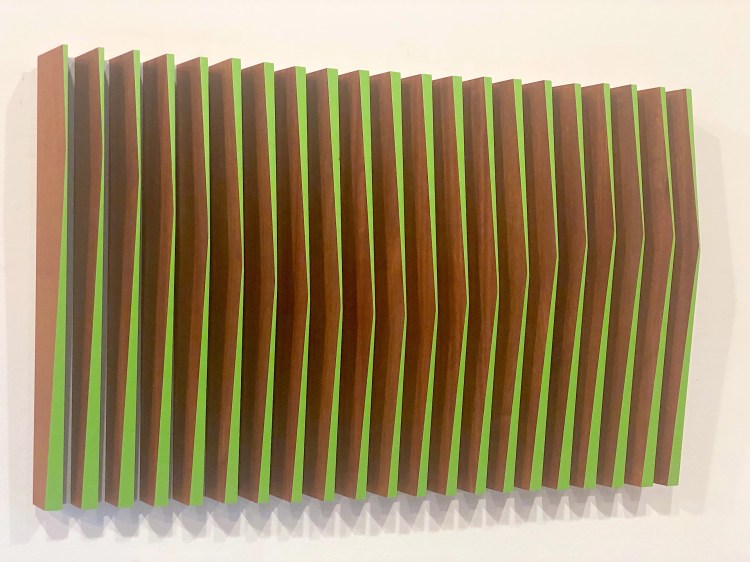

Jamie Johnston, “May Sixth,” wood and paint, 28 x 14 x 4 inches Photo courtesy of the artist
“May Sixth” amplifies this effect with fin-like vertical pieces of wood whose widest widths are at different heights. So, whether we’re moving from left to right or right to left, the sculpture seems to create a wave that swoops down and then up again. “Disturbance” assembles wooden blocks painted mostly with green on two opposite sides, except for about seven of them in which opposite sides are painted red. These are placed into a grid obliquely angled to the surface, the red ones scattered randomly throughout and causing the “disturbance” of the title.
It’s endlessly interesting to see how Johnston manipulates his modules to create different effects. All these artists’ works are physically fixed and stationary, yet they read as coming into being or dissolving, in motion (at least visually), and ever morphing.
WHAT DOES JEWISHNESS LOOK LIKE?
Photographer Yoav Horesh is the child of a Persian Jewish mother and a Slovak Jewish father (hence the show’s title). Their black-and-white portraits hang at intervals around the Fineberg Community Room at the Maine Jewish Museum, along with portraits of various siblings, aunts and uncles, cousins and the Kittery-based Horesh himself. The portraits are straight-on and documentarian, recording in close-up the shapes of faces and their features, the wrinkles and facial hair and other elements of each family member.
But this show is much more than straight portrait photography. To one side of the room stands a podium on which a projector casts an image of one of Horesh’s relatives onto the wall before you. Over seven years, the artist catalogued hundreds of images of his family members’ facial features, categorizing them into types: eyes, noses, mouths, hair, etc. They are modules, if you will.
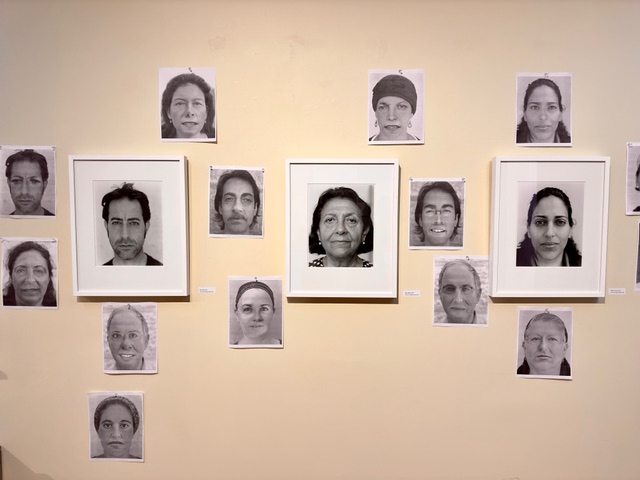

Visitors can add their own creations to the portraits in “PerSlovak 2.0,” which include one of artist Yoav Horesh, pictured in the leftmost frame. Photo by Nanci Kahn
Atop the projector is a box with buttons you can push repeatedly to shift these modules: drawing this pair of eyes from the eye file and combining it – by pushing other buttons – with another relative’s nose, yet another relative’s hair and so on. When you feel you are finished, another button allows you to print out your creation and use a push pin to affix it to the wall around Horesh’s formal family portraits.
Fun, right? Well, yes, it can be. But if we psychologically mine beneath an activity that seems purely amusing, we might be surprised what we can discover and what beliefs can be challenged. The interactive component of this exhibition presents a question: What constitutes a “Jewish” face? It might shock some to discover that the way they answer this question on a daily basis is filled with assumptions and generalizations that, at their worst, can dehumanize people and justify racial and cultural abuse.
For example, right from the start, we are dealing with two strains of Jewishness: Sephardic and Ashkenazi. Just contemplating what genetic features accompany these cultural varieties in our minds can be problematic. But widening that inquiry to distinguish Sephardim from non-Jewish North Africans, for instance, complicates things even further. Is there truly a physical difference between them that allows us to definitively tell them apart? How do we know, without interacting with a person, whether they are Sephardic or Ashkenazi? What assumptions do we make about each of these ethnic groups? What value judgements might be lingering in our subconscious?
As you look around the room at visitors’ amalgamations of features, you might begin to notice that some look downright freakish, with features that don’t seem in proportion with others (enormous eyes ala Marty Feldman, for instance, paired with a tiny mouth or a drawn, sunken jawbone. Are these just fun and games? Or is there something more sinister or antisemitic in that playfulness? How might these less overt prejudices be informing our opinions about the current tragedy exploding in the Gaza Strip?
Of course, the same Dr. Frankenstein-like experimentation can lead us to appreciate the infinite permutations of Jewishness and the inherent uniqueness and individuality of every soul. It might reaffirm for us the insubstantiality of ethnic stereotypes, or stereotyping in general for that matter. And on and on. “PerSlovak 2.0,” as it turns out, is much more than it seems.
Related Stories



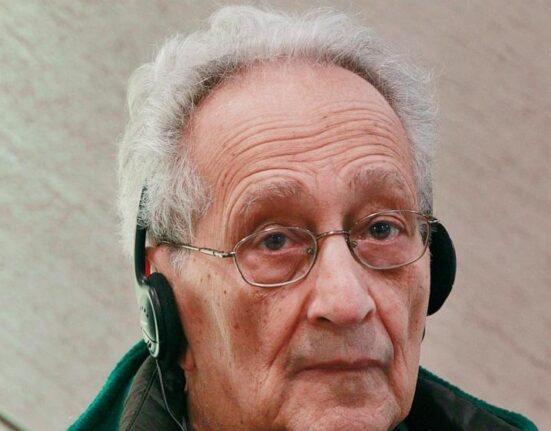
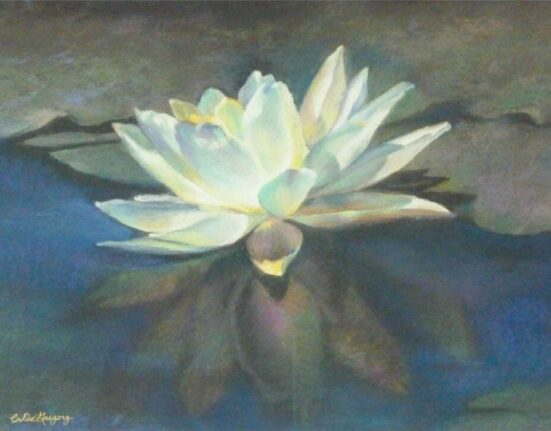

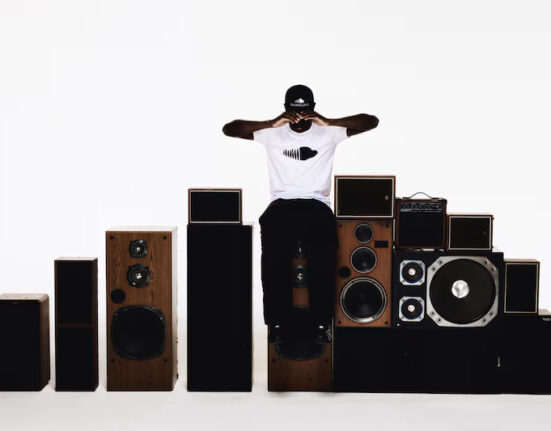


Invalid username/password.
Please check your email to confirm and complete your registration.
Use the form below to reset your password. When you’ve submitted your account email, we will send an email with a reset code.